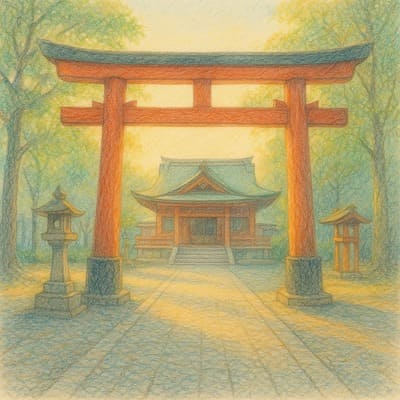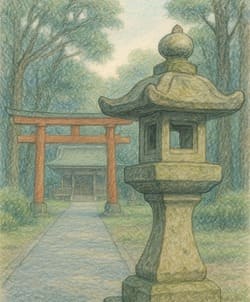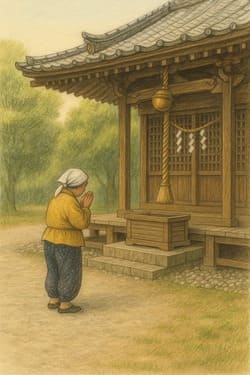A Morning Visit to a Shrine
– Where Silence Speaks
1. Visiting a Shrine in the Morning
Japanese people visit shrines at New Year to pray for peace and health, celebrate Christmas with cake and fried chicken, and hold Buddhist funerals when someone passes away. In other words, they somehow blend Shinto, Christianity, and Buddhism into their lifestyle without much conflict.
While the Japanese Constitution guarantees freedom of religion, the person who drafted that article is probably in heaven—or the Pure Land—sighing, “That’s not exactly what I meant…”
That said, shrines—each dedicated to a local deity—have long been deeply rooted in Japanese life. People offer daily prayers there and hold sacred rituals at life’s major milestones. The idea that gods reside in all things, a core belief of Shinto, still quietly lives on in the hearts of many. And perhaps it resonates with the very nature of the Japanese people themselves.
A shrine is a sacred space, and it is in the morning that its mystique is most palpable.
When the sun has yet to rise fully and the world is still half-asleep, standing alone in a silent courtyard may allow you to sense the presence of something divine.
It’s a fleeting moment where you just might glimpse the quiet spirituality woven into Japanese life.


2. What You’ll Find There

“Have you ever visited a shrine in the morning?”
It was a gentleman at a bar, seated next to me by chance, who asked me that.
Back then, I was struggling with work relationships, and with a bit of alcohol in me, I ended up confiding in this complete stranger.
His advice? “Try going to a shrine in the morning.”
That was nearly ten years ago.
Even now, from time to time, I find myself visiting a shrine at dawn.
A shrine’s morning begins gently.
The path that leads beyond the red torii gate is still cloaked in dim light, and there’s no sign of people.
In March, the morning air is cool and tingles faintly in your nose.
The damp gravel underfoot makes a soft crunch, which somehow only deepens the silence.
Climbing the gentle slope to the inner courtyard, still wrapped in early shadows, I find no one there.
The bell at the worship hall remains still, as if asleep.
I place my hand on a stone lantern and close my eyes.
Its cold, rough texture reminds me that everything in this world has its own form and presence.
Soon, birds will start to sing, and light will quietly spill into the space.
Then, I hear a bell chime behind me—softly, almost apologetically.
I turn around to see an elderly woman standing at the offering box, bowing slightly as she claps her hands in prayer.
She must come here every morning, offering quiet prayers for someone.
I wonder if that someone knows.
I hope they do.
Looking up, the sky seems a bit more blue than before.
A faint breeze stirs the hem of my coat.
Spring is near.

3. How to Try
- Opening hours:
Most shrines open around 6:00 AM. Some, like Meiji Shrine (Tokyo) or Shimogamo Shrine (Kyoto), open as early as 5:00 AM. - What to wear:
Neat, comfortable clothes. Avoid making noise—mornings are sacred and quiet. - Etiquette:
Bow before entering through the torii gate. Walk to the side of the path, not the center. Bow again when you leave. - What to do:
You can pray, or simply observe. Feel the air. Listen to the sounds. Touch the stone. That’s enough.
Also available: Not All Sushi!, a site sharing more on Japan travel and culture.